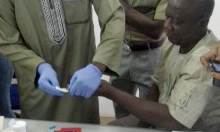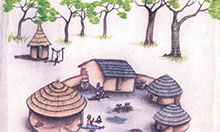Background
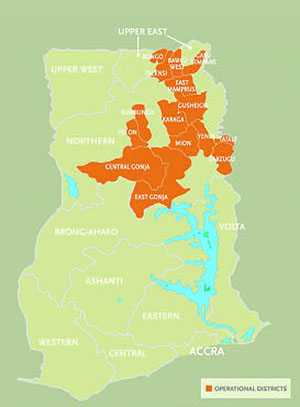
The Power of Radio
Our radio serial drama tells a relatable story to encourage improved IYCF practices.
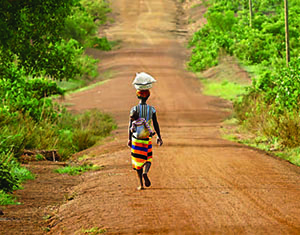
The Shrubs of Today Become Tomorrow’s Forest serial radio drama follows Suhuyini, a young male reporter, as he accompanies Madame Abiba, a retired nurse, during her visits with caregivers and families to help them protect, nourish, and nurture pregnant women and children under two years. The episodes, featuring a lively dialogue format, support breastfeeding, complementary feeding, and hygiene practices that can have a positive impact on child health. They also encourage the engagement of all household members, particularly fathers and older children, in many of the suggested practices.
In the past decade, Ghana has made significant strides in tackling poverty and providing access to basic services. But progress has not been uniform across the country. In northern Ghana, these improvements have not reached the majority of people, and those who are most vulnerable have seen deepening poverty (UNICEF 2011).
As a result, many children in the country continue to suffer from serious and preventable health issues, including those stemming from malnutrition. Across the country, nearly one in five children is stunted, a condition caused by chronic undernutrition and characterized by low height for age. The situation is far worse in the country’s Northern region, where one in every three children (33 percent) is stunted (DHS 2014). Stunting can result in lifelong cognitive and physical deficits, and can keep a child from reaching his or her full potential in adulthood.
Additionally, 66 percent of children under age five are anemic. Anemia caused by iron deficiency, illnesses such as malaria, and parasites is a major threat to child health and a leading cause of maternal mortality in young women who carry their anemia from childhood to adolescence (DHS 2014).
The Government of Ghana is committed to reducing the persistent problems of stunting in young children and anemia in women and children. USAID/Ghana funded SPRING to join this effort in the agency’s Feed the Future zone of influence, which encompasses 15 of the most vulnerable districts in the Northern and Upper East regions of the country.
About SPRING
USAID’s Strengthening Partnerships, Results, and Innovations in Nutrition Globally (SPRING) project is a seven-year cooperative agreement dedicated to strengthening global and country efforts to scale up high-impact nutrition practices and policies and improve maternal and child nutrition outcomes. We provide state-of-the-art technical support focused on preventing stunting and maternal and child anemia in the first 1,000 days of life, from pregnancy through age two. The project links the sectors of nutrition, WASH (water, sanitation, and hygiene), and agriculture, and employs social and behavior change communication approaches at all levels.
SPRING’s Multi-sectoral Approach in Ghana
The leading causes of stunting and anemia are poor diets, especially low dietary diversity, and poor sanitation infrastructure and practices that lead to intestinal infections, which interfere with achieving and sustaining nutrition gains. To combat these problems, we identified behaviors across the nutrition, WASH, and agriculture sectors that—when synthesized into a holistic approach and implemented together in target communities—can contribute to improved nutrition outcomes.
To support the Government of Ghana in alleviating the high rates of stunting and anemia, we implemented a multi-sectoral program, combining the rollout of critical Ghana Health Service (GHS) activities with additional SPRING-led initiatives.
This multifaceted strategy included—
- Training health workers on good infant and young child feeding (IYCF) practices; nutrition counseling techniques; and improved prevention, diagnosis, and treatment of anemia
- Promoting four key WASH behaviors to prevent—especially among young children—contact with fecal contamination, which can impede the body’s absorption of nutrients
- Teaching of good agronomic practices that help improve yields of diverse crops and reduce aflatoxin contamination in groundnuts, which also impedes nutrient absorption
- Focusing on the 1,000-day household as the centerpiece of multiple interventions.
A Focus on Ghana’s 1,000-Day Households
To ensure that our multi-sectoral approach to improved nutrition had the greatest impact, we focused on 1,000-day households, those with pregnant and lactating women and children up to age two.
During this time, children are most vulnerable to developing nutrition-related health conditions such as stunting and anemia, which lead to diminished capacity to learn and increased susceptibility to infection and disease. Such damage during the first 1,000 days—particularly from stunting—can be irreversible, severely reducing a child’s potential for a healthy and productive life and contributing to a prolonged cycle of intergenerational poverty (Grantham-McGregor and Baker-Henningham 2005). For these reasons, the first 1,000 days is the critical window for nutrition support.
Working with the nutrition, WASH, and agriculture sectors in selected communities, we devised a plan to deliver an integrated package of products, services, and information from all three sectors at the same time where the need is greatest—in 1,000-day households. This multi-sectoral approach is designed to better support the ability of the 1,000-day household to care for and support the 1,000-day child.
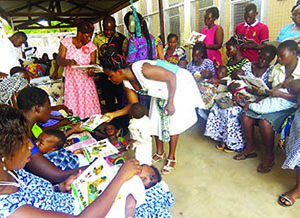
Helping Health Workers Connect
Using a WhatsApp messaging group, health workers access professional support and guidance, even in remote regions.
At a community IYCF training for health workers that we conducted in 2015 in theTolondistrict of the Northern region, a participant asked how trainees could access information and support each other as they worked in distant communities. This inspired the SPRING district coordinator to create a WhatsApp messaging group for the health staff who participated in the training. Thegrouphasexpandedovertime,andnowhas54 members, with at least one point person who owns a smartphone at each of the 11 participating health facilities. Group members include midwives and nurses.
Because frontline health workers play an invaluable role in improving IYCF practices, helping them communicate well is important. The health workers use the messaging group to get help with their IYCF-related questions. Responses and support come from both colleagues and SPRING district officers. This sharing of information and experiences enables us to improve the capacity of health workers to deal with real-life problems and provide the best advice to families.
The Power of Video
Our advocacy documentary appeals to male community members and leaders.
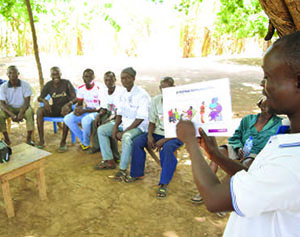
To galvanize attention to the serious problem of stunting in northern Ghana and the importance of nutrition during the first 1,000 days, we produced a documentary-style video, When a King Has Good Counsellors, His Reign Is Peaceful. The video recognizes the key role of men in both sanctioning actions and controlling resources: it carefully depicts the important role of men,inparticularmaleleaders, as positive role models in addressing the immediate and underlying causes of stunting. Shown widely, the video has been seen by more than 1,600 influential leaders across the 15 project districts. It has sparked conversations and commitments to a variety of nutrition-promoting actions.
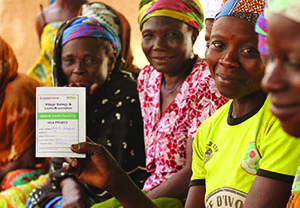
Village savings and loan associations and the LEAP 1,000 cash transfer program help build nutrition resilience
Achieving proper nutrition often requires families to find additional financial resources to carry out recommended behaviors. To help address this challenge, we rolled out village savings and loan associations (VSLAs) to 49 communities in seven districts, enabling MTMSG members to improve their economic status through subscribed savings and access to small loans for immediate needs. By economically empowering women, we enabled them to put good nutrition behaviors, such as the purchase of nutrient-rich foods and more and varied seeds for their gardens, into practice.
We also improved families’ economic means for better nutrition by working through an existing poverty alleviation program, the USAID-funded Livelihood Empowerment Against Poverty (LEAP 1,000) program. Many families in the north rely on farming for a living and may face economic difficulties as a result of unfavorable weather patterns, illness, or a lack of access to agriculture inputs. LEAP 1,000 provides cash transfers to give families—especially those with pregnant and lactating mothers—the means to access health care and maintain proper nutrition during these times.
Once LEAP 1,000 was launched in 2015, we prioritized these communities for support, enrolling community members in a wide range of SPRING nutrition-related activities and encouraging them to make improved nutrition part of their LEAP benefit through the purchase of healthy, diverse foods.
Better Anemia Testing
To help improve the diagnosing of anemia, we distributed HemoCue blood-testing devices to health facilities. This made it possible to test more patients and increased the credibility of test results.
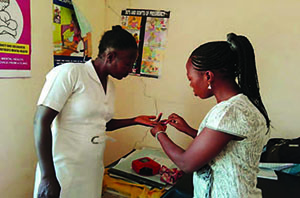
“Previously, when health workers could only diagnose anemia by evaluating a patient’s eyes and skin, the patient may not take it seriously,” said Salamatu Seidu,principalmidwifeattheFufulso CHPS facility in Central Gonja district. “The HemoCue machines have been very, very important to us. When patients get results through HemoCue testing, they take it more seriously. We have now seen our anemia rates go down.” Though anemia rates initially rose as a result of an increase in the number of people tested, some health workers have reported the rate is now in decline as a result of improved anemia management protocols.
Hajia Adishetu Abukari, director of health services at Central Gonja District Health Center, has also seen a significant improvement in the diagnosing of anemia with the use of HemoCue machines. “In 2015, out of more than 5,000 patients seen at this facility, only 1,000 were tested for anemia. In 2016, about 3,000 out of 5,000 patients were tested.”
Nutrition-Specific Initiatives in Ghana
Although all of our activities were carried out with the goal of nutrition improvement, this brief covers the nutrition-specific activities focused on improving maternal, infant, and young child dietary practices and related health sector services. We led or supported a number of initiatives in Ghana aimed at reducing rates of stunting and anemia.
1. Rolling Out and Expanding the GHS-UNICEF IYCF Training Package
In 2014, we began nutrition-specific work in Ghana by supporting the rollout of the GHS-UNICEF community-based IYCF package in the 15 SPRING districts. This package offers a set of generic, adaptable tools for programming and capacity development in IYCF counseling as well as for developing community-support for improved IYCF. The main components are training tools to equip community health workers (CHWs) with knowledge and skills related to recommended breastfeeding and complementary feeding practices for children from birth to 24 months.
The IYCF package aims to encourage and support behaviors that have a high impact on reducing stunting, specifically:
- Early initiation of breastfeeding
- Exclusive breastfeeding for six months
- Continued breastfeeding for two years
- Appropriate complementary feeding beginning at six months
To help strengthen IYCF behaviors in northern Ghana, we expanded UNICEF’s IYCF package by developing additional innovative tools:
- A community IYCF supplemental training package for Ghana’s community health volunteers (CHVs), who work closely with community members and health workers
- Short counseling videos (less than a minute and a half) that CHVs can play on their mobile devices to show community members key practices that are difficult to convey with drawings: how to properly position and attach a baby for breastfeeding, and how to enrich porridge with mashed yam
- Discussion guides on IYCF topics for mother-to-mother support groups
- Job aids (picture charts and a key messages brochure on IYCF) for CHWs
In the past three years, we have conducted IYCF trainings for more than 1,500 health staff, more than 2,500 CHVs, and numerous community support groups in 405 communities and 285 health facilities in the Northern and Upper East regions of Ghana.
2. Initiating Mother-to-Mother Support Groups
As part of the implementation of the national IYCF package, we helped develop mother-to-mother support groups (MTMSGs). Across the 15 SPRING project districts, we worked with community-based health planning and services (CHPS) facilities, CHWs, CHVs, and community leaders to establish and train 300 MTMSGs. These groups served as a peer education platform for caregivers to learn about better nutrition practices.
Each MTMSG had 15 members, including pregnant or lactating women from 1,000-day households, caregivers of children under two years of age, two traditional birth attendants, and at least two grandmothers from the community, plus a CHV serving as facilitator. We trained CHVs in the support group component of the IYCF national package and provided them with guides for group discussions and counseling cards for individual, household, and group discussions.
Supporting improved IYCF practices, we adapted a six-part radio serial with 15-minute episodes—The Shrubs of Today Become Tomorrow’s Forest—to the context of northern Ghana. The program was translated into five local languages and aired on eight local radio stations and through MTMSGs. Using radio sets and memory cards mother-to-mother support groups played the episodes at their meetings to spark discussion. The episodes supported breastfeeding, complementary feeding, and hygiene practices that can have a positive impact on child health. They also encouraged the engagement of all household members, particularly fathers and older children, in many of the suggested practices.
With supervisory support from CHWs, trained CHVs used the the serial radio drama and discussion guide to lead groups through a series of sessions covering IYCF and hygiene practices. Participants were encouraged to discuss strategies, practice key behaviors at home, and support each other in overcoming challenges.
In one MTMSG in Gabuliga community in Bawku West district, group members say the meetings helped increase their awareness about child nutrition. “We didn’t know about the importance of mixed foods, and that giving food like liver helped to prevent stunting,” said one participant. The group was encouraged to find doable and affordable strategies for providing mixed foods, and together, they decided to help each other cultivate soybeans to provide a source of protein for their children.
After her mother-to-mother support group began meeting two years ago in Gundu community in Tolon district, one mother put into practice what she learned about child nutrition with her two children, who are two and four years old. As a result, she has noticed a significant difference in how well her two-year-old child — who received proper nutrition from birth—has grown, as compared to the growth of her four-year-old child during the first two years of life.
Similarly, an MTMSG member in Liwalebo community in Mion district gave her four oldest children water before they were six months old. After participating in the support group, she exclusively breastfed her fifth and youngest child. She says, “I have seen less diarrhea and better health in my baby.”
3. Piloting Father-to-Father Support Groups
In 2017, we began piloting father-to-father support groups (FTFSGs) in four communities in two districts. This innovative, gender-sensitive approach encouraged male community members to be influential change agents who positively contribute to good nutrition outcomes for family members during the first 1,000 days.
With the support of a gender specialist, we developed a package of materials that included laminated illustrated cards on nutrition and group discussions guides. The gender specialist helped train CHVs to facilitate these support groups. Like MTMSGs, the fathers’ groups listened to The Shrubs of Today Become Tomorrow’s Forest serial radio drama using SPRING-provided radio sets, and talked about what they learned.
Men in the FTFSGs, which included natural WASH leaders or husbands of MTMSG members, made commitments to nutrition-promoting behaviors, recorded them in a notebook, and tracked progress during monthly meetings. The men also provided encouragement to those who were not able to reach a new goal.
Members made commitments such as—
- Boiling water for drinking
- Helping wives fetch firewood for cooking
- Supporting wives in cooking
- Taking care of children while wives cook
- Helping bathe the children
They also improved hygiene practices in their families and noticed that children were getting sick less often as a result.
In Liwalebo community in Mion district, fathers saw a lot of change brought about through the FTFSG; they even shared this progress with non-SPRING communities to encourage them to make their own improvements.
MTMSG members in Liwalebo were happy that the men became more engaged in their families through the fathers’ group and were more willing to share in labor in the home. Household relationships and communication improved, they said. “Before, men and women handled different things and remained separate,” one mother stated. “Now, men are more interested in what the family is doing, and they ask wives about what children are eating.”
Another mother added, “The head of my household used to watch me struggle with my child and cooking and doing chores. Now he helps me with the child or with cooking.” The women are also seeing the men offer money to buy liver, take a sick child to the health clinic, or pay for transportation to the hospital for their wives to give birth—even attending the births themselves.
An assessment of the FTFSG pilot program is underway, and will yield more insight into the effectiveness of the rollout and the acceptance of the program within communities. Results are expected in late 2017.
4. Community and Facility Quality Improvement
Quality improvement (QI) consists of systematic and continuous actions that lead to measurable improvement in health care services and the health status of targeted patient groups.
In Ghana, two actions contributed to the reduction of stunting and anemia in 1,000-day households:
- Attendance at antenatal care (ANC) clinics, where women can access screening and treatment for anemia and are encouraged to improve their nutritional status
- Attendance of newborns and young children at child welfare clinics (CWCs), where their growth and anemia status are monitored.
However, in both ANC and CWC settings, caregivers found facility waiting times to be prolonged, partly as a result of poor patient flow and counseling given to all attendees regardless of status. SPRING staff also observed that growth-monitoring charts for young children were filled out inaccurately, preventing proper diagnosis and treatment of children at risk for undernutrition.
To improve ANC and CWC attendance, we took an innovative QI approach, working to improve facility-based nutrition services and increase demand for community-based nutrition services. We implemented both community quality improvement (C-QI) and facility quality improvement (F-QI) programs in 105 communities in seven districts.
First, we conducted a critical assessment of identified problems within the community or health facility environment. Next, we developed doable actions that required no external resources—that is, targeted change ideas. We identified and trained QI teams at the community and health facility levels to support the implementation of this approach and help ensure its sustainability. In addition, we trained coaches to help C-QI and F-QI teams with the QI process.
Where coaches played an active role in guiding the teams, both C-QI and F-QI showed effectiveness in encouraging attendance at ANC and CWC and increasing the proper use of growth monitoring cards at facilities. Over a period of 4–12 months, health facilities showed a 30–60 percent improvement in their chosen targeted change ideas.
5. Strengthening GHS’s Anemia Programming
GHS has struggled with high anemia prevalence and the identification of effective programming options for some time. To support the GHS, we conducted a landscape analysis that provided information on risk factors, programmatic coverage, and the country’s policies; we also developed and piloted the District Assessment Tool for Anemia (DATA) to assist in prioritizing district-level actions and increasing awareness of the multi-sectoral effort needed to prevent and treat anemia.
GHS recognized that an important factor in the country’s high prevalence of anemia was the less-than-optimal capacity of health facility personnel and CHVs to prevent and treat anemia. To support GHS’s efforts to enhance capacity, we supplied HemoCue® testing devices to health facilities to improve the detection of anemia, and developed a comprehensive resource package for capacity building in anemia control.
The training package covers the basics, including how to prioritize interventions to address the causes of anemia in each district. Building on the introduction of the package to 459 health workers and 275 CHVs across the 15 project districts, the manuals and training process will be used nationwide.
GHS and SPRING began rolling out this package by training a cadre of master trainers at the regional level. The master trainers went on to train district-level teams, who in turn traveled across their districts, training colleagues in health facilities and CHVs from surrounding communities. Previously, health workers and CHVs played complementary roles in the community implementation of various anemia interventions, but opportunities were missed for them to work together. The training curriculum addressed this gap by having health workers train CHVs, creating an opportunity for collaboration between the two groups.
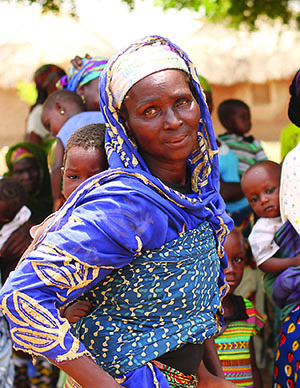
Conclusion
Nutrition improvement among children under two years of age and women in northern Ghana can be achieved when basic nutrition fundamentals are addressed, as shown by the successes of our work in the country.
A focus on 1,000-day households; coordinated, enhanced IYCF capacity development; and promotion of small doable nutrition actions at both the health facility and community levels were critical to our achievement, and have led to an increased vigor and ownership of solutions to reduce malnutrition in northern Ghana.
Challenges/Opportunities for Improvement
- GHS experienced a high staff attrition rate, resulting in continuous training needs at the health facility level.
- Some health facilities are not using the SPRING materials (such as the flipchart booklet and job aids), as evidenced by the fact that staff members can’t find them when our staff visit, or that the materials appear to be in brand-new condition.
- The number of supportive supervision visits to health workers and community health volunteers was inadequate.
- In the communities, steep levels of poverty make adding diversity to diets very challenging, a problem further compounded during the dry season when foods are less available and, therefore, more expensive.
References
Ghana Statistical Service (GSS), Ghana Health Service (GHS), and ICF International. 2015. Ghana Demographic and Health Survey 2014. Rockville, Maryland, USA: GSS, GHS, and ICF International.
Grantham-McGregor, S., and H. Baker-Henningham. 2005. “Review of Evidence Linking Protein and Energy to Mental Development.” Public Health Nutrition 8(7A): 1191–201.
UNICEF. Situation of Children in Ghana. 2011. https://www.unicef.org/ghana/about_7587.html
